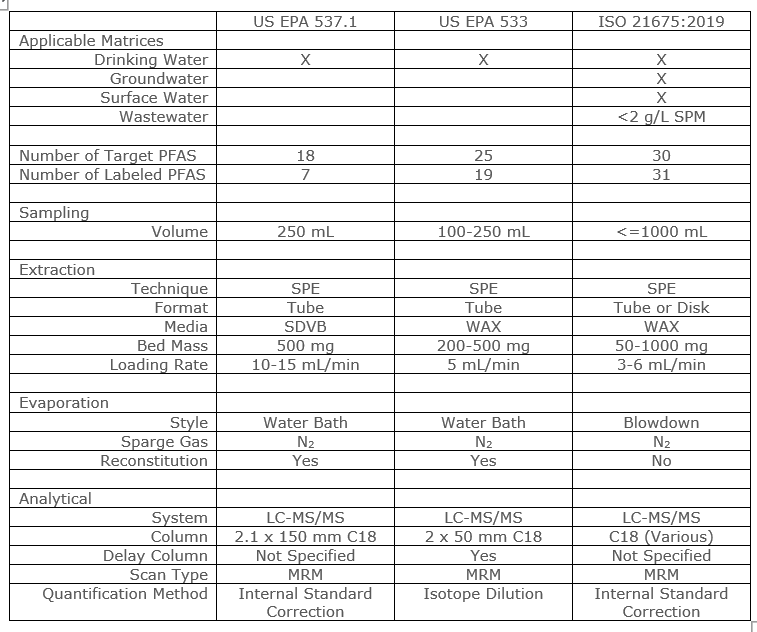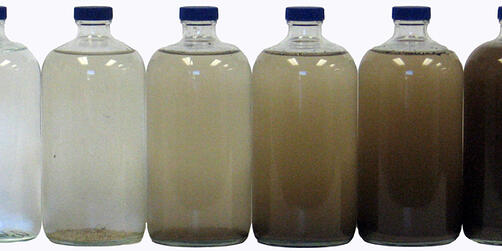As the title indicates, this is Part 2 of an ongoing series where we discuss what’s going on with PFAS. For those of you who may not have read Part 1, you missed out on a summary of the controversy surrounding this group of compounds and I would recommend going back and taking a quick read through it to make sure that you’re caught up.
For those of you who are all caught up, today’s post is going to run through three of the top sample preparation methods which we see being used as a basis for PFAS testing in water around the world. They are: United States Environmental Protection Agency (US EPA) Method 537.1, US EPA Method 533, and International Organization for Standardization (ISO) 21675. Here’s a quick table with some basic information about each of the methods listed side-by-side to make the future discussion a little easier.

With only a cursory glance at the methods it’s very easy to think that they’re quite similar; after all, all three methods outline procedures for the extraction of PFAS compounds from aqueous matrices using solid phase extraction (SPE) techniques. However, taking a slightly deeper look into the methods reveals just how different they truly are.
The first big area of disagreement is in the types of sample matrices that each of the methods are applicable to. Where both US EPA methods apply specifically to drinking water only, the ISO method expands its applicability to groundwater, surface water, and wastewater. From the chemical background, to the amount of solids, ask anyone who’s seen a “typical” sample for each of these matrices and they’ll tell you, this is strange! The assumptions and extra considerations that everyone in a laboratory has to make about a wastewater sample versus a drinking water sample are drastically different. This is probably why ISO 21675 needed to include extra protocols within the method itself. In fact, of the three we are looking at, this is the only method which specifically allows the use of SPE disks as an alternative to columns and includes a technique to filter and extract any suspended materials (SPM) using sonication.

The next thing that stands out is the number of compounds and the type of media used to extract them from the sample itself. Because our knowledge of the types of PFAS compounds released into the environment is still evolving, it makes sense that the methods being released have evolved over the years as well. US EPA 537.1 is the oldest of the methods we’re looking at and, if we compare this to US EPA 533 and ISO 21675, both released in 2019, it’s easy to see how our understanding of the PFAS problem influenced the methods being released. Where method 537.1 tests for the smallest number of compounds, 18, and uses an SPE tube with polystyrenedivinylbenzene, both of the newer methods test for more target compounds and switched to a weak anion exchange media to allow for the targeting of some of the new, smaller PFAS compounds which were added to the lists. Additionally, as you look towards the tracking of the quality of the sample preparation process, you’ll see a decided jump in the number of labeled PFAS compounds used in the process, going from 7 labeled compounds originally all the way up to over 30. Seeing changes like this implemented into regulatory methods clearly shows that our knowledge of the target compounds has improved.
And lastly, the biggest difference in these methods doesn’t really have so much to do with the method itself, but with the body that created the method and the requirements that go along with that. In short, the US EPA is a regulatory body and so has the ability to include the specific quality control requirements that are needed to implement methods within the scope of its jurisdiction. This ends up making method 537.1 and 533 a sort of complete package, outlining not just the procedure, but the rules as well (at least on a federal level). This isn’t the case with ISO 21675. Because ISO is not a regulatory body, but an independent organization, any specific quality control requirements ultimately need to come from the regulatory body which governs the region and which is applying the standard. This means, while governments may call out ISO 21675 for the procedure, anyone looking to apply the standard must refer to local jurisdictions for the acceptance criteria.
Overall, each of the methods discussed are excellent solutions to extract PFAS from aqueous samples, and the choice of which method is right for you should be made strictly based on your needs and the regulations that you have to follow. In the next post, we’ll move the topic a little further forward, diving a little deeper into the reasons why we would select one of the three methods over the others.
If you are interested in catching up on Part 1, click here. To read more about PFAS in our latest application note click the link below.

 Organic Workflow
Organic Workflow Peptide Workflow
Peptide Workflow Scale-Up Flash Purification
Scale-Up Flash Purification  Sample Preparation
Sample Preparation Biomolecule Purification
Biomolecule Purification Oligo synthesis
Oligo synthesis Scavengers and Reagents
Scavengers and Reagents Service & Support
Service & Support Accessories & Spare parts
Accessories & Spare parts Investors
Investors Reports & News
Reports & News The Share
The Share Corporate Governance
Corporate Governance Calendar
Calendar Sustainability
Sustainability Our Offering
Our Offering Our History
Our History Our Locations
Our Locations Leadership
Leadership